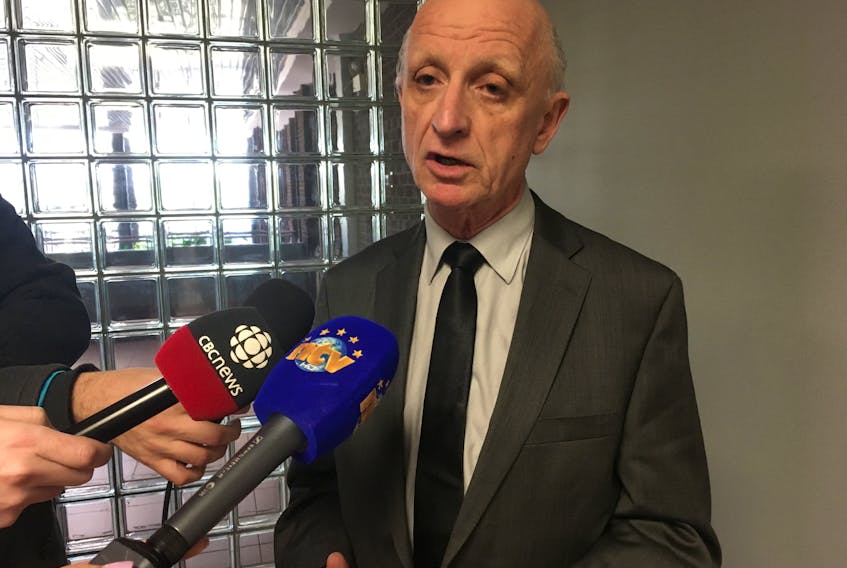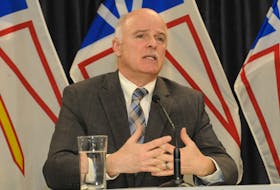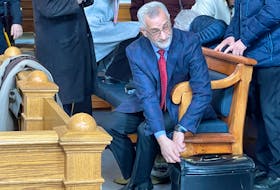Consumer Advocate Dennis Browne cross-examined Newfoundland and Labrador Hydro president Jim Haynes on Monday during ongoing rate hearings at the Public Utilities Board.
Browne hammered away, asking what Newfoundland and Labrador Hydro has done to help address costs, now being transferred to ratepayers. He was particularly concerned with impending rate hikes for the Muskrat Falls hydroelectric project.
Browne asked about Hydro executive bonuses (the corporation’s short-term incentive plan), any reductions in operational costs and the options for reducing the charges now facing power consumers — suggesting an aggressive energy conservation program to help customers rapidly reduce their power usage.
A response to one of nearly 300 requests for information filed in the lead-up to hearings by the Consumer Advocate’s Office shows $704,552 in executive and senior leadership bonuses paid in 2017 (covering work in 2016).
Haynes said bonuses would be paid for 2017 as well, because the incentive program remains in place.
Another document cited by Browne showed 126 Hydro employees with overtime payments of $40,000 or more in 2016, the highest being $139,427 earned in overtime atop an annual salary of $95,272, by an electrical and mechanical supervisor. Fifteen employees earned more in overtime than their annual salary.
The overtime list included a range of different positions — technologists, electricians, thermal power plant operators — and Haynes said it was full of expenses likely to be reduced over the next few years, as the utility gets through the transition away from use of Holyrood thermal power and onto Muskrat Falls hydro power.
As for an energy conservation program on the island?
“There’s merit to encouraging whatever reasonable electric load we can have on the island,” Haynes said, explaining the utility wants to retain its customers by finding a way to keep power rates to a reasonable level, while still covering its own cash requirements.
- still have a fixed cost more or less that we have to recover,” he said.
Through questioning, the consumer advocate highlighted a lack of ability to openly discuss certain information as part of the current PUB review, including the cost of power already imported in 2018 into the once-isolated island power system over the Maritime Link, or the exact origins of that power. That information is subject to a decision still to come around confidentiality, under application from Hydro.
Browne asked Haynes at one point if he had come to believe the Muskrat Falls power project, undertaken by Hydro parent Nalcor Energy, was a mistake.
“I’m not sure,” Haynes replied.
He referred to a general preference for hydro versus thermal power, but also to hindsight being 20/20.
He acknowledged the project’s cost and schedule overruns.
“I don’t have an answer,” he said.
In addressing the hike in rates expected when Muskrat Falls comes online, Hydro is proposing a deferral account, where it can tuck away money saved by importing power to the island between now and full Muskrat Falls power — an alternative to using more expensive power from the Holyrood thermal plant. Any money in that account would be returned to customers as Muskrat Falls-affected rates hit, according to the proposal, to help “smooth out” increases.
It won’t be enough to eliminate them, but the idea is to make the transition to higher rates less painful.
Browne ultimately accused the Crown corporation of not doing enough, and continuing “business as usual” in a time of “crisis” in the electrical power system.
“We need to find the best way of dealing with these rates and I don’t think what we’re hearing today even comes close,” Browne said.
“The consumers of the province, we’re not low-hanging fruit here, that our wallets need to be opened up to assist Nalcor and Hydro in this project. We’re already paying enough as taxpayers. So the idea they would only come forward with one idea, which is their idea, is a bit disheartening.”
On immediate costs, Haynes said new infrastructure and refits have improved system reliability, but at a cost.
On operating expenses, he mentioned everything from travel to payroll falling under new scrutiny.
He is not yet finished his time before the PUB and did not take questions outside the hearing room.
A statement was issued by Dawn Dalley, Hydro’s vice-president of sales and regulatory services.
“We fully understand that customers are concerned about electricity rates and we, at Hydro, share those concerns. We know that all rate increases are difficult for customers and because of this we have, and continue to, carefully examine our costs and consider available options in an effort to reduce overall impact of this rate change,” she stated.
Dalley said Hydro remains open to any options brought forward to help with rising power rates, “and we continue to work with the Public Utilities Board, interveners, the provincial government and Nalcor Energy to find ways to lower the impact on our customers.”
Public hearings on Hydro’s 2017 general rate application are set to continue through Thursday, before a break in the process to allow the PUB to continue its auto insurance rate review.
Technically, more than one power rate increase is currently under consideration. There is a proposed total 7.5 per cent increase for island interconnected customers that would come into effect on Canada Day (this includes an interim rate increase, and the annual adjustment under the rate stabilization plan), with another 9.4 per cent increase proposed for New Years’ Day, 2019.
Proposed rate changes
• Newfoundland and Labrador Hydro has asked for an interim rate increase of 2.8 per cent for most island residential customers, effective on July 1, 2018.
• Another 4.7 per cent increase is proposed, to be introduced the same day. This change would actually be the annual adjustment to the provincial Rate Stabilization Plan (RSP), designed to keep rates where they need to be in the face of ever-changing oil prices, and differences in hydro reservoir levels. (Together, the two increases would amount to a 7.5 per cent increase on Canada Day, or about 0.9 cents per kilowatt hour.)
• There is a separate, 9.4 per cent increase for average island interconnected customers — a general rate increase that is the main focus of the ongoing hearings. If approved, it would start to be applied on Jan. 1, 2019.









